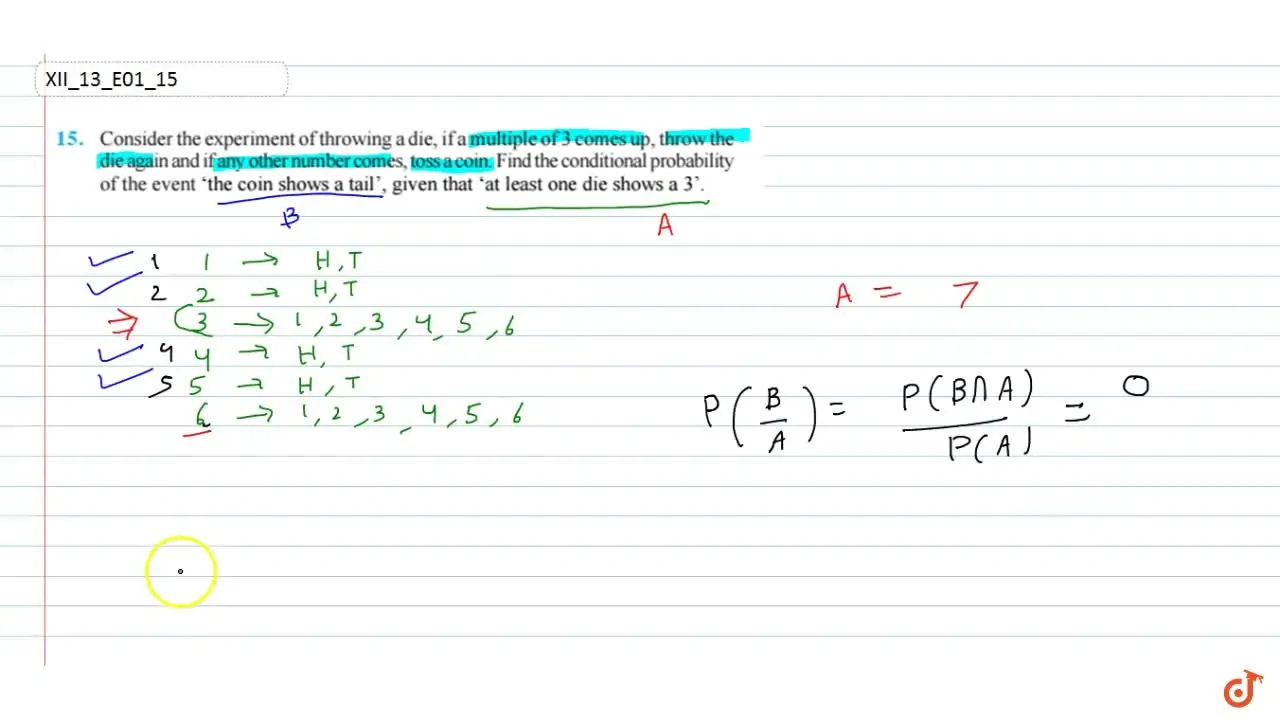Consider the experiment of throwing a die. if a multiple of 3 comes tip. throw the die again and if any other number comes, toss a coin Find the conditional probability of the event the coin shows a tail, given that at least one die shows a 3.
A tree diagram is represented to show the outcomes of the given experiment.
sample space S of the experiment:
S={(1,H)(1,T)(2,H)(2,T)(3,1)(3,2)(3,3)(3,4)(3,5)(3,6)(4,H)(4,T)(5,H)(5,T)(6,1)(6,2)(6,3)(6,4)(6,5)(6,6)}
Let A be that event when coin shows tail and B be that event when at least one die gives 3.
So, A=(1,T)(2,T)(3,T)(4,T)
B={(3,1)(3,2)(3,3)(3,4)(3,5)(6,3)(3,6)}
since,(A∩B)=ϕ
hence, P(A∩B)=0
now, P(B)=P{(3,1)}+P{(3,2)}+P{(3,3)}+P{(3,4)}+P{(3,5)}+P{(3,6)}+P{(6,3)}
=136+136+136+136+136+136+136
=736
The required probability for coin showing a tail when at least one die shows 3 will be-
P(A∣B)=P(A∩B)P(B)
=07=0
Thus, such probability will be 0
Related Playlists
- BOOK - NCERTCHAPTER - PROBABILITYEXERCISE - MISCELLANEOUS EXERCISE19videos
PROBABILITY
- BOOK - NCERTCHAPTER - PROBABILITYEXERCISE - EXERCISE 13.515videos
PROBABILITY
- BOOK - NCERTCHAPTER - PROBABILITYEXERCISE - Solved Examples36videos
PROBABILITY
- BOOK - NCERTCHAPTER - MATRICESEXERCISE - EXERCISE 3.312videos
MATRICES
- BOOK - NCERTCHAPTER - RELATIONS AND FUNCTIONSEXERCISE - EXERCISE 1.314videos
RELATIONS AND FUNCTIONS
Similar Questions
Consider the experiment of throwing a die, if a multiple of 3 comes up throw the die again and if any other number comes toss a coin. Find the conditional probability of the event the coin shows a tail, given that at least one die shows a 3.
View SolutionConsider the experiment of tossing a coin. If the coin shows head, toss it again but if it shows tail then throw a die. Find the conditional probability of the event that the die shows a number greater than 4 given that there is at least one tail.
View SolutionFind the probability that the sum of the numbers showing on two dice is 8, given that at least one die does not show five.
View SolutionIndicate the probability of the following events
a multiple of 3, in one throw of one die.View SolutionA coin is tossed and a die is rolled. The probability that the coin shows head and the die shows 3 is
View SolutionThree fair coins are tossed. Find the probability that the outcomes are all tails, if atleast one of the coins shows a tail.
View SolutionConsider a random experiment of throwing together a die and two coins. The associated sample space has
View SolutionThree coins are tossed simultaneously. Find the probability that all coins show heads if at least one of the coins shows a head.
View SolutionThree fair coins are tossed. Find the probability that they are all tails, if one of the coins shows a tail.
View SolutionA die is thrown, find the probability of the event of getting a number less than 3.
View Solution


